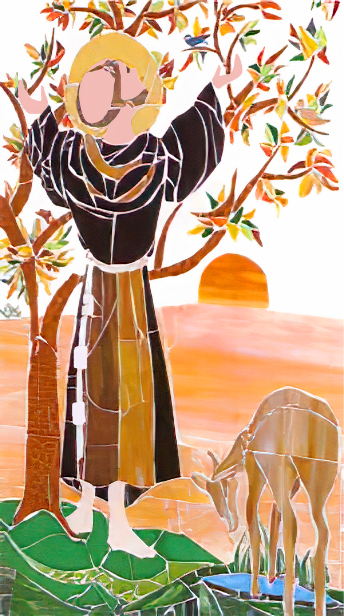Saint Francis Mosaic
Catholic-inspired mosaics often feature religious scenes and symbols, such as depictions of the saints, the Virgin Mary, or Christ. These images can be used to enhance the religious significance of a space, whether it's a church, home chapel, or religious institution.
A mosaic is a collocation of pieces of marble, glass, ceramic material, or precious stone embedded in some species of cement so as to form an ornamental entity. rm mosaic would also be made to apply to the opus sectile (Vitruvius, VII, i) made of pieces of marble and glass forming geometrical or foliated patterns, each piece being ground exactly to fit into the design or in the case of pictures, ground to make the shapes necessary for the completion of the subject.
The great period of Christian mosaic was probably in the thirteenth century. Rome, Florence, Pisa, Venice, Parenzo, and Spoleto still possess great works of this era, and the names of Cimabue, Giotto, P. Cavallini, Gaddo Gaddi, Jacobus Torriti, Tafi, Apollonio, and others are connected with the craft. Torriti did important work in St. Mary Major's and St. John Lateran's; Pietro Cavallini designed the subjects under the apse of S. Maria in Trastevere; important mosaics were done in St. Peter's, St. Clement's, and other churches.
In 1298 the great Giotto was called to Rome to design the "navicella" for the Porch of St. Peter's; that now in situ is a restoration. In Florence the mosaics of the baptistery commenced in 1225 by Jacobus, a Franciscan, were continued at the end of the century by Andrea Tafi, Gaddo Gaddi, Apollonio, and afterwards by Agnolo Gaddi. Gaddo Gaddi also did the beautiful "Madonna" at Santa Maria del Fiore, and the "majesty" at San Miniato is also attributed to him, but it is so much restored that it is difficult to pass judgement upon it.
At the end of the century (1298-1301) there was executed the celebrated "majesty" in the apse of the cathedral at Pisa. This has generally been attributed to Cimabue and the side figures to Vicino. To this opinion Venturi adheres with strong evidence (Storia dell'Arte Italiana V, 239-240). Gerspach, however, will not have Cimabue amongst the mosaicists (La Mosaique, 127). At Cività Castelana there is a considerable work by the Cosmati, who possessed a school of architects, artists, and mosaicists. They not only did mosaic pictures or subjects, but enriched the altars, pulpits, columns, pavements, and other portions of the architecture with geometrical mosaic patterns.
This image is a public domain image, which means either that copyright has expired in the image or the copyright holder has waived their copyright. Franciscan Gallery charges for the access to high resolution copy of the image. Manually restoration was necessary in order to improve quality, without covering the original image.






Comments
Post a Comment